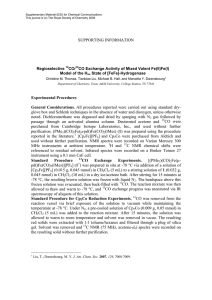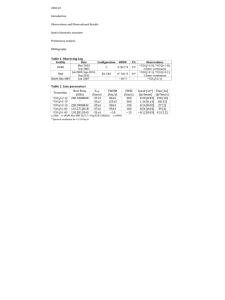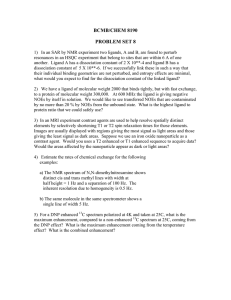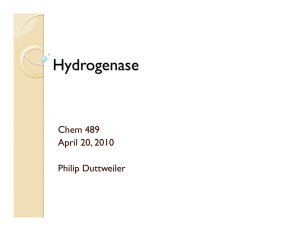Detection of Charge Distribution in Diiron Hydrogenase Model
advertisement
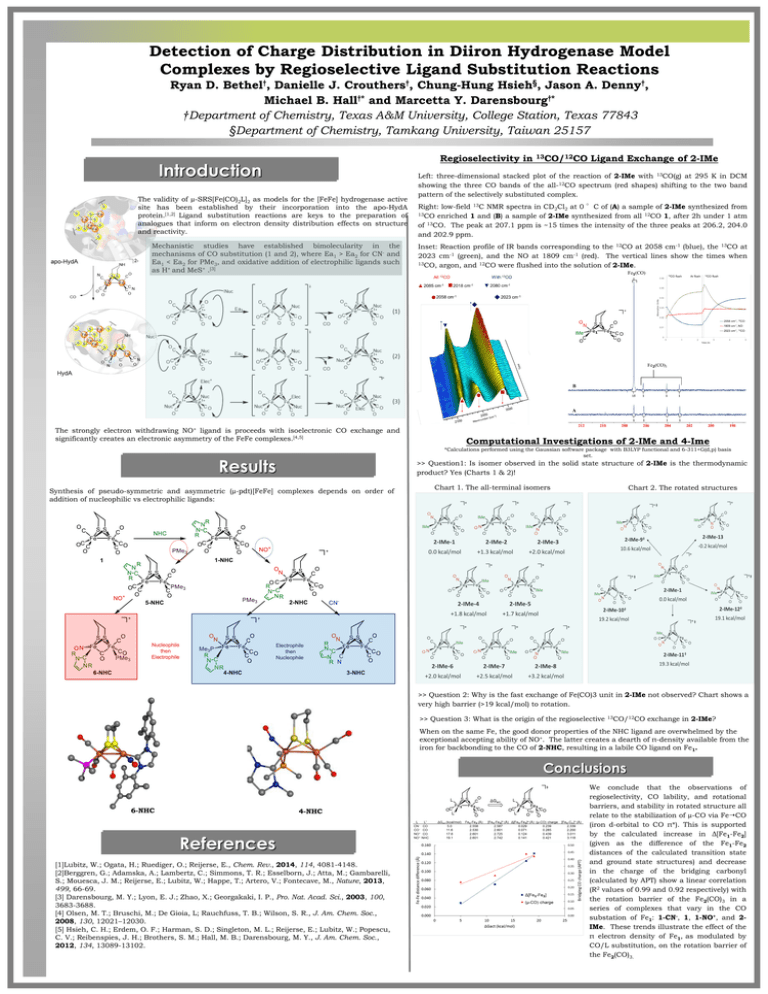
Detection of Charge Distribution in Diiron Hydrogenase Model Complexes by Regioselective Ligand Substitution Reactions Ryan D. Bethel†, Danielle J. Crouthers†, Chung-Hung Hsieh§, Jason A. Denny†, Michael B. Hall†* and Marcetta Y. Darensbourg†* †Department of Chemistry, Texas A&M University, College Station, Texas 77843 §Department of Chemistry, Tamkang University, Taiwan 25157 Regioselectivity in Introduction The validity of µ-SRS[Fe(CO)2L]2 as models for the [FeFe] hydrogenase active site has been established by their incorporation into the apo-HydA protein.[1,2] Ligand substitution reactions are keys to the preparation of analogues that inform on electron density distribution effects on structure and reactivity. Mechanistic studies have established bimolecularity in the mechanisms of CO substitution (1 and 2), where Ea1 > Ea2 for CN- and Ea1 < Ea2 for PMe3, and oxidative addition of electrophilic ligands such as H+ and MeS+ .[3] The strongly electron withdrawing NO+ ligand is proceeds with isoelectronic CO exchange and significantly creates an electronic asymmetry of the FeFe complexes.[4,5] Ligand Exchange of 2-IMe Left: three-dimensional stacked plot of the reaction of 2-IMe with 13CO(g) at 295 K in DCM showing the three CO bands of the all-12CO spectrum (red shapes) shifting to the two band pattern of the selectively substituted complex. Right: low-field 13C NMR spectra in CD2Cl2 at 0 °C of (A) a sample of 2-IMe synthesized from 13CO enriched 1 and (B) a sample of 2-IMe synthesized from all 12CO 1, after 2h under 1 atm of 13CO. The peak at 207.1 ppm is ~15 times the intensity of the three peaks at 206.2, 204.0 and 202.9 ppm. Inset: Reaction profile of IR bands corresponding to the 12CO at 2058 cm-1 (blue), the 13CO at 2023 cm-1 (green), and the NO at 1809 cm-1 (red). The vertical lines show the times when 13CO, argon, and 12CO were flushed into the solution of 2-IMe. Computational Investigations of 2-IMe and 4-Ime *Calculations performed using the Gaussian software package with B3LYP functional and 6-311+G(d,p) basis set. Results >> Question1: Is isomer observed in the solid state structure of 2-IMe is the thermodynamic product? Yes (Charts 1 & 2)! Synthesis of pseudo-symmetric and asymmetric (µ-pdt)[FeFe] complexes depends on order of addition of nucleophilic vs electrophilic ligands: Nucleophile then Electrophile 13CO/12CO Chart 1. The all-terminal isomers Chart 2. The rotated structures Electrophile then Nucleophile >> Question 2: Why is the fast exchange of Fe(CO)3 unit in 2-IMe not observed? Chart shows a very high barrier (>19 kcal/mol) to rotation. >> Question 3: What is the origin of the regioselective 13CO/12CO exchange in 2-IMe? When on the same Fe, the good donor properties of the NHC ligand are overwhelmed by the exceptional accepting ability of NO+. The latter creates a dearth of π-density available from the iron for backbonding to the CO of 2-NHC, resulting in a labile CO ligand on Fe1. Conclusions 6-NHC 4-NHC References [1]Lubitz, W.; Ogata, H.; Ruediger, O.; Reijerse, E., Chem. Rev., 2014, 114, 4081-4148. [2]Berggren, G.; Adamska, A.; Lambertz, C.; Simmons, T. R.; Esselborn, J.; Atta, M.; Gambarelli, S.; Mouesca, J. M.; Reijerse, E.; Lubitz, W.; Happe, T.; Artero, V.; Fontecave, M., Nature, 2013, 499, 66-69. [3] Darensbourg, M. Y.; Lyon, E. J.; Zhao, X.; Georgakaki, I. P., Pro. Nat. Acad. Sci., 2003, 100, 3683-3688. [4] Olsen, M. T.; Bruschi, M.; De Gioia, L; Rauchfuss, T. B.; Wilson, S. R., J. Am. Chem. Soc., 2008, 130, 12021–12030. [5] Hsieh, C. H.; Erdem, O. F.; Harman, S. D.; Singleton, M. L.; Reijerse, E.; Lubitz, W.; Popescu, C. V.; Reibenspies, J. H.; Brothers, S. M.; Hall, M. B.; Darensbourg, M. Y., J. Am. Chem. Soc., 2012, 134, 13089-13102. We conclude that the observations of regioselectivity, CO lability, and rotational barriers, and stability in rotated structure all relate to the stabilization of µ-CO via FeCO (iron d-orbital to CO π*). This is supported by the calculated increase in Δ[Fe1-Fe2] (given as the difference of the Fe1-Fe2 distances of the calculated transition state and ground state structures) and decrease in the charge of the bridging carbonyl (calculated by APT) show a linear correlation (R2 values of 0.99 and 0.92 respectively) with the rotation barrier of the Fe2(CO)3 in a series of complexes that vary in the CO substation of Fe1: 1-CN-, 1, 1-NO+, and 2IMe. These trends illustrate the effect of the π electron density of Fe1, as modulated by CO/L substitution, on the rotation barrier of the Fe2(CO)3.
